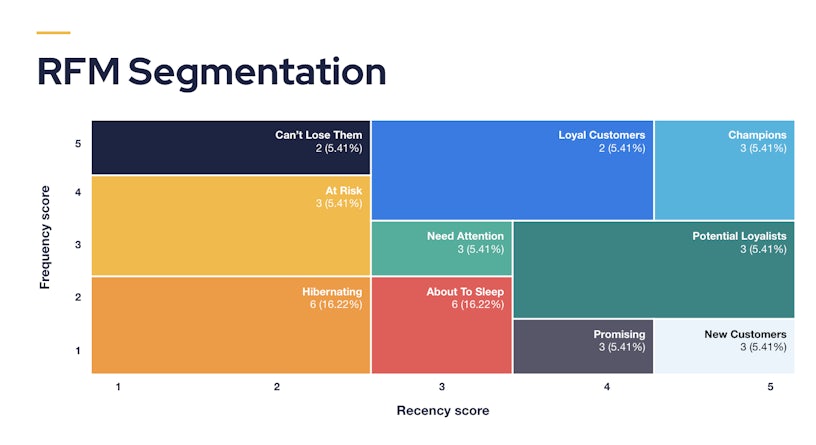In the intricate landscape of marketing strategies, RFM segmentation is a powerful tool for businesses aiming to tailor and optimise their approach to individual customer marketing.
- What is RFM segmentation?
- Recency
- Frequency
- Monetary Value
- How does RFM work?
- Benefits of RFM segmentation
- Targeted marketing
- Customer retention
- Resource optimisation
- Improved customer experience
- Activation across marketing channels
- Email communications
- Ad platform audience synchronisation
- Frequently asked questions
- How often should RFM analysis be conducted?
- Can RFM segmentation be applied to all industries?
- Is RFM segmentation suitable for small businesses?
- What makes RFM valuable?
What is RFM segmentation?
RFM stands for Recency, Frequency, and Monetary Value, three critical dimensions that are pivotal in understanding customer behaviour, engagement and ultimately – value. Let’s demystify what these three dimensions are.

Recency
‘Receny’ is a time-based metric that looks at when the customer last interacted with the brand. Customers who have interacted recently are more likely to be receptive to marketing messaging. Analysing recency helps in identifying customers who may need re-engagement or personalised communication.
Frequency
How often does the customer interact with the brand? Frequency is an engagement-based metric that gauges customer loyalty. Higher frequency often correlates with stronger loyalty, making these customers prime candidates for loyalty programmes or exclusive offers.
Monetary Value
What is the total value of the customer’s transactions – often referred to as ‘customer lifetime value’ or “CLV”? Monetary value provides insights into a customer’s contribution to revenue. High monetary value customers may warrant exclusive perks or targeted promotions to maximise their value.
How does RFM work?
RFM analysis involves assigning these metric scores to customers based on their behaviour in each dimension. These scores are then combined to create segments that reveal distinct customer profiles.
By transitioning from raw data to actionable insights, RFM segmentation categorises customers into segments like “Champions” (high RFM scores) and “At-Risk” (low scores). This segmentation is the foundation for personalised marketing strategies.
Benefits of RFM segmentation
Targeted marketing
RFM segmentation allows businesses to tailor their marketing strategies to specific customer segments. Understanding each segment’s needs and preferences makes marketing efforts more precise, leading to higher conversion rates.
Customer retention
By identifying at-risk customers, businesses can implement targeted retention strategies. Whether exclusive offers, personalised communication, or loyalty programmes, RFM segmentation aids in retaining valuable customers.
Resource optimisation
RFM ensures that marketing resources are allocated efficiently. Instead of applying a one-size-fits-all approach, businesses can focus their efforts where they’re most likely to yield the highest returns, saving both time and resources.
Improved customer experience
Businesses can tailor communications based on customer behaviour to create a more personalised and enjoyable customer experience. This not only boosts satisfaction but also strengthens the customer-brand relationship.
Activation across marketing channels
Email communications
RFM segments provide a foundation for personalised email and Marketing Automation campaigns. Businesses can craft messages that resonate with each segment, increasing the likelihood of engagement and conversion.
Ad platform audience synchronisation
By synchronising RFM segments with ad platforms, businesses can deliver targeted ads to specific customer groups. This approach is effective for exclusion (excluding current customers from certain campaigns) or lookalike audience generation.
Frequently asked questions
How often should RFM analysis be conducted?
RFM analysis is not a one-time task. Many Customer Data Platforms, Marketing Automation platforms, or CRMs can be set up to automatically segment your customer base live on an ongoing basis, once a set of rules are in place. This means it can be ongoing but without human intervention. Otherwise, regular analysis, preferably quarterly or semi-annually, ensures that marketing strategies align with evolving customer behaviour.
Can RFM segmentation be applied to all industries?
Yes, RFM segmentation is versatile and can be adapted to various industries, from e-commerce to healthcare. The key lies in understanding and customising the dimensions based on industry specifics.
Is RFM segmentation suitable for small businesses?
Absolutely. RFM segmentation is scalable and can be tailored to suit the size and resources of any business. It’s a valuable strategy for small businesses aiming to make the most of their marketing efforts.
What makes RFM valuable?
RFM segmentation and analysis stand as a robust method for businesses seeking to elevate their marketing game. From targeted communications to resource optimisation, the benefits are manifold. By incorporating RFM into a customer data platform, businesses can activate these insights across all marketing channels, ensuring a cohesive and effective strategy.
In the dynamic marketing realm, RFM segmentation is not just a tool; it’s a game-changer.





